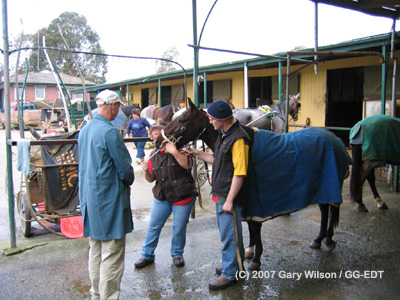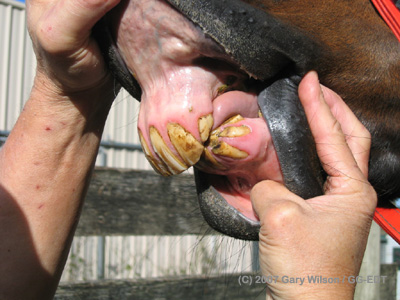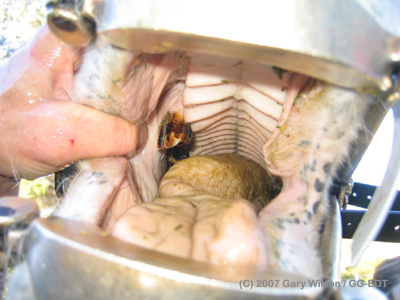
Find me on Facebook!
Training and cases
Training
It's important when choosing a dental practitioner to understand what level of training someone has had. You can then decide whether they are not only skillful enough in filing of teeth, but also knowledgable enough in order to perform full and consistent oral checks. They should be able to pick up on anything from lacerations of the bars and cheeks, no matter how small, to diagnosing periodontal disease at the gingival margins (and how advanced this is), to correctly diagnosing whether the dental arcades are straight, or have a wave mouth, step mouth, serrated bite, transverse ridges along with knowing the functional and causal differences between a parrot mouth and an overbite.
They must also know what the correct treatment for each patient is as an individual, and whether correction is achievable in one visit, or whether a staged correction is required in order not to give the horse any eating problems or discomfort through over-correction at any one time.

Training at a harness horse yard
Gary Wilson's training has been achieved in Australia, through the Australian Equine Dental Practice, which is a dental practice operating for over 38 years and has established a reputation for producing knowledgable and skilled dental practitioners. Indeed its founder, Peter Borgdorff, has also founded the Equine Dental Practitioners Association, which aims to bring a proceduralised and documented approach to equine dentistry based on an ISO9000 based model. This applies not only in Australia, but in time across the globe in order to ensure a set quality in its practitioners, ensuring the customer's job of finding a "good" dental practitioner is easier. Gary aims to be part of this association and hopes to help form the ISO based documents and procedures using his previous ISO skills from his IT career.
The AEDP provides a relatively long time framed training schedule compared to most other courses available, and this is because it is an in depth course aimed only at people who have degree level education or similar experience AND who have an appreciable working knowledge of horses for a number of years. Gary qualified for this course as he has a BSc degree, has been owning and working horses for over 7 years and has already passed a number of BHS courses over the past 3 years.
The course contained a lengthy theory section covering the history of equine evolution, equine anatomy (total anatomy, not just structures, which included neurology, cardiovascular, blood and lymph systems, digestive systems, glands and ducts, muscles, bones, respiratory systems, organ construction and use, endocrine / hormone systems and much much more). The course then focussed on head anatomy, along with feeding, bitting and bridles, feeding and preperation for racehorses, disease and illness, biosecurity, condition scoring, drugs and their usage, and of course everything about dentistry.
This is followed by an "apprenticeship" section of the course where all the theory is put into practice out in Australia, initially by attending and performing numerous dissections at a knackery, as well as learning the techniques of diagnosing and correcting oral conditons. He then travelled around Victoria and parts of New South Wales visiting, diagnosing and treating real patients, from rescue horses all the way up to $40,000 racehorses (indeed Gary treated two such racehorses, correcting disorders and removing deciduous teeth, and both horses went on to race and win less than 4 days later).

A classic parrot mouth
The beauty of this kind of training with the AEDP's wide client base is getting to see pretty much every kind of horse in every kind of situation, with every kind of oral disorder from normal sharpness all the way down to the staged correction of significant stepped mouths. From youngstock needing caps removing to elderly horses experiencing enamel depletion.
The other benefit of training with the AEDP is that the courses only ever have a maximum of 4 students per course, unlike most other courses who try and get as many students in as possible, the AEDP training is about training smaller groups to a higher standard, giving what is essentially one to one training at most times, and at most one to two training (as you tend to work as 2 groups of 2 through a lot of the patients).
Testing of students is by way of 4 seperate exams, the first is a 5 hour written theory exam designed to regurgitate what was learned in the lengthy distance learning section, and 3 seperate practical exams, two are routine treatment exams, and one major case, performing a major extraction or similar level of work, working with a veterinary surgeon. Gary's major case was working with a horse called Jewel, a 28 year old bay mare, who required 2 permanent teeth extracting due to periodontitis (gum disease).
There are a few pictures and more about this case in the cases section below. Gary passed all of his exams first time, and also spent some time with another dental practitioner from the AEDP with his patients in another area of Victoria, and also received very positive feedback regarding his progress. In total, during the apprenticeship stage of training, Gary built up a case book of over 40 patients seen and treated exclusively by Gary, he helped his training partner in over 40 other cases and has witnessed and/or partially helped in excess of 50 other routines.
As mentioned in the section about GG-EDT's ethos and ways of working, Gary is committed to continued learning and will never rely solely on his training - equine dentistry is about always learning, always seeking new knowledge and techniques and sharing this with those who want to learn, and make horse's lives better.

Extremely extended 106 molar
Cases
Below are a selection of interesting cases dealt with and/or witnessed by Gary. Because these are generally more major cases, appropriate use of sedatives were required for some cases.
Each link opens a new window or tab on your browser. Simply close the case window to return to this page.
Case: Jewel - 29 year old bright bay mare
Case: Red - 7 year old bay gelding racehorse
Case: King - 25-28 year grey gelding
Case: Unknown - Bay gelding
© 2007-2025 Gary Wilson / GG-EDT All rights reserved. GG-EDT, the "horse heart" device and associated names and logos are TM Gary Wilson.
